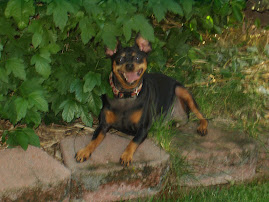"When a man's best friend is his dog, that dog has a problem."
-- Edward Abbey
"The reason a dog has so many friends is that he wags his tail instead of his tongue."
--Anonymous
"Dogs feel very strongly that they should always go with you in the car, in case the need should arise for them to bark violently at nothing right in your ear."
-- Dave Barry
"Dogs need to sniff the ground; it's how they keep abreast of current events. The ground is a giant dog newspaper, containing all kinds of late-breaking dog news items, which, if they are especially urgent, are often continued in the next yard."
--Dave Barry
"A dog teaches a boy fidelity, perseverance, and to turn around three times before lying down."
-- Robert Benchley
"A dog is the only thing on earth that loves you more than he loves himself."
-- Josh Billings
"In order to keep a true perspective of one's importance, everyone should have a dog that will worship him and a cat that will ignore him."
-- Dereke Bruce, Taipei, Taiwan
"Of all the things I miss from veterinary practice, puppy breath is one of the most fond memories!"
-- Dr. Tom Cat
"You enter into a certain amount of madness when you marry a person with pets."
-- Nora Ephron
"We give dogs time we can spare, space we can spare and love we can spare. And in return, dogs give us their all. It's the best deal man has ever made"
--M. Facklam
"Dogs love their friends and bite their enemies, quite unlike people, who are incapable of pure love and always have to mix love and hate."
--Sigmund Freud
"Women and cats will do as they please, and men and dogs should relax and get used to the idea."
-- Robert A. Heinlein
"Whoever said you can't buy happiness forgot about puppies."
-- Gene Hill
"To his dog, every man is Napoleon; hence the constant popularity of dogs."
-- Aldous Huxley
"Man is a dog's idea of what God should be."
-- Holbrook Jackson
"Anybody who doesn't know what soap tastes like never washed a dog."
--Franklin P. Jones
"Don't accept your dog's admiration as conclusive evidence that you are wonderful."
-- Ann Landers
"No animal should ever jump up on the dining room furniture unless absolutely certain that he can hold his own in the conversation."
-- Fran Lebowitz
"Outside of a dog, a book is probably man's best friend; inside of a dog, it's too dark to read."
-- Groucho Marx
"No one appreciates the very special genius of your conversation as the dog does."
-- Christopher Morley
"I wonder what goes through his mind when he sees us peeing in his water bowl."
--Penny Ward Moser
"Did you ever walk into a room and forget why you walked in? I think that's how dogs spend their lives."
-- Sue Murphy
"If there are no dogs in Heaven, then when I die I want to go where they went."
--Will Rogers
"The average dog is a nicer person than the average person."
--Andrew A. Rooney
"I wonder if other dogs think poodles are members of a weird religious cult."
-- Rita Rudner
"I loathe people who keep dogs. They are cowards who haven't got the guts to bite people themselves."
-- August Strindberg
"If I have any beliefs about immortality, it is that certain dogs I have known will go to heaven, and very, very few persons."
-- James Thurber
"If you pick up a starving dog and make him prosperous, he will not bite you; that is the principal difference between a dog and a man."
-- Mark Twain
"Ever consider what they must think of us? I mean, here we come back from a grocery store with the most amazing haul - chicken, pork, half a cow. They must think we're the greatest hunters on earth!"
-- Anne Tyler
"My dog is worried about the economy because Alpo is up to $3.00 a can. That's almost $21.00 in dog money."
--Joe Weinstein
"There is no psychiatrist in the world like a puppy licking your face."
-- Ben Williams
"Cat's motto No matter what you've done wrong, always try to make it look like the dog did it."
-- Unknown
"He is your friend, your partner, your defender, your dog. You are his life, his love, his leader. He will be yours, faithful and true, to the last beat of his heart. You owe it to him to be worthy of such devotion."
-- Unknown
"If your dog is fat, you aren't getting enough exercise."
--Unknown
"In dog years, I'm dead."
-- Unknown
"Money will buy you a pretty good dog, but it won't buy the wag of his tail."
-- Unknown
"Some days you're the dog; some days you're the hydrant."
-- Unknown
"Things that upset a terrier may pass virtually unnoticed by a Great Dane." -- Unknown


 Bullmastiff
Bullmastiff








